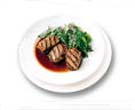|
|
Cuisine Glossary
| You have reached our International Cuisines and information on all aspects of a countries cuisine.
We will try to explain the culture, significant influences, climate, and other factors that have come together to create a distinct style. For example: Spanish, Mexican or Japanese. |
Argentinian Cuisine
 |
Argentinians eat four meals each day. The diet may differ in different regions. Desayuno (breakfast) is a light meal of rolls and jam with coffee. For almuerzo (lunch), many Argentinians eat meat and vegetables or salads. After work but before dinner, people go to confiterías (cafés) to drink espresso and eat picadas, small dishes of cheese, mussels, salami, anchovies, olives and peanuts. Cena (dinner) in the evening is the largest meal of the day and almost always includes beef.
The tradition of eating beef began in the 19th century, when there were thousands of cattle in the Pampas region. Beef was roasted on a spit on an open fire. When it was done, people sliced off chunks. They ate by holding the end of a chunk in their mouths and cutting off the rest with a knife. Today, beef is served in many ways. Bife a caballo (beef on horseback) is steak topped with an egg. Parrillada is blood sausage, ribs and other meat grilled together. Churrasco is grilled steak and milanesa is deep-fried breaded beef. It is common for Argentinians to socialize over an asado, beef roast barbecued over an open fire. Many restaurants offer asado con cuero, whole beef roasted complete with hide and hair. Yerba mate is a popular traditional drink, similar to tea. There are several ways of drinking yerba mate. The most traditional is mate cebado. Hot water is poured over the leaves of the yerba plant (an evergreen shrub related to holly) in a mate (gourd), which is often decorated with silver. When the gourd is filled with water, the leaves expand and fill the mate. People drink through a bombilla (straw with a strainer) made of silver. Source: HungryMonster Writers |




